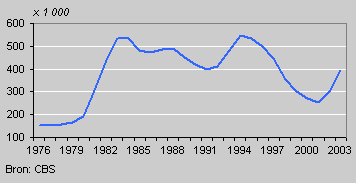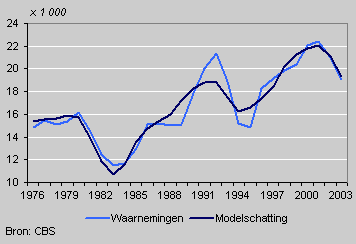High unemployment curbs immigration from EU-15

In 2003 19 thousand immigrants from EU countries - the EU-15 – arrived in the Netherlands, down from 22 thousand in 2001. The decrease in immigration is connected with the rise in unemployment in the Netherlands.
Unemployed labour force

Immigration and the economy
The number of immigrants from the fourteen EU countries has increased in the last quarter of a century. In the mid seventies some 15 thousand EU immigrants a year came to the Netherlands. By around 2000 this had risen to more than 20 thousand. In addition to the overall increase, the annual number of immigrants in this period also shows fluctuations which are connected with the economic cycle.
Unemployment has undergone three periods of hefty increase in the last quarter of a century: at the beginning of the eighties, the first half of the nineties and in 2002-2003. In each of these periods immigration of EU citizens to the Netherlands decreased. Similarly, periods of falling unemployment were accompanied by an increase in immigration.
Higher unemployment curbs immigration
Calculations on the basis of developments since 1976 in immigration from the EU-15 and unemployment show that an increase in unemployment of 100 thousand leads to 2 thousand fewer EU immigrants..
The unemployed labour force rose by nearly 150 thousand between 2001 and 2003. This explains the fall in immigration by 3 thousand, from 22 thousand in 2001 to 19 thousand in 2003.
Immigrants from the EU-15

English immigrants sensitive to the economy
The number of immigrants from the United Kingdom in particular shows a strong correlation with the most recent cyclical developments. About half the increase of EU immigration between 1995 and 2001 and half of the fall between 2001 and 2003 were accounted for by immigrants from the UK. Immigration of Germans on the other hand has no relationship at all with the economic situation. Their numbers fell continually between 1995 and 2003.
Trend levelling off
The rate of increase in the trend in EU immigration has been levelling off since the nineties. Based on the course of this trend, an estimate can be made of the future numbers of immigrants from the EU-15.
If unemployment is 300 thousand (the average in the last five years) 21 thousand EU immigrants a year can be expected to arrive in the Netherlands. If it is 400 thousand (the average in the last 25 years) immigration will be 19 thousand a year. If unemployment drops to 200 thousand EU immigration will increase to 23 thousand a year. These estimations are only relevant for the EU countries before enlargement on 1 May 2004.
Accession countries
Fewer than 3 thousand immigrants from the ten new countries came to the Netherlands in 2003. Most by far were Poles (1.5 thousand). Only a few hundred immigrants come from Hungary and the Czech Republic, and fewer still from the other accession countries.
Interestingly, during the last wave in the economic cycle immigration from the ten new countries showed a development similar to that of immigration from the EU-15: an increase between 1995 and 2001 and a fall from 2001. This would seem to indicate that immigration from the new countries, too, has a correlation with unemployment in the Netherlands.
Joop de Beer